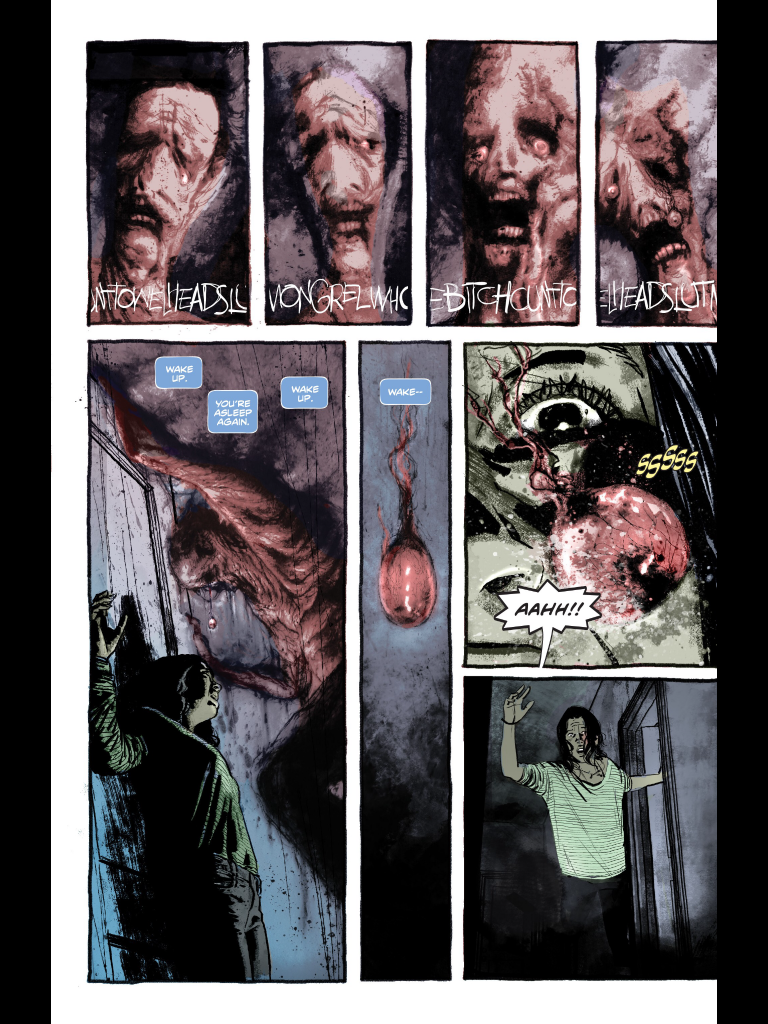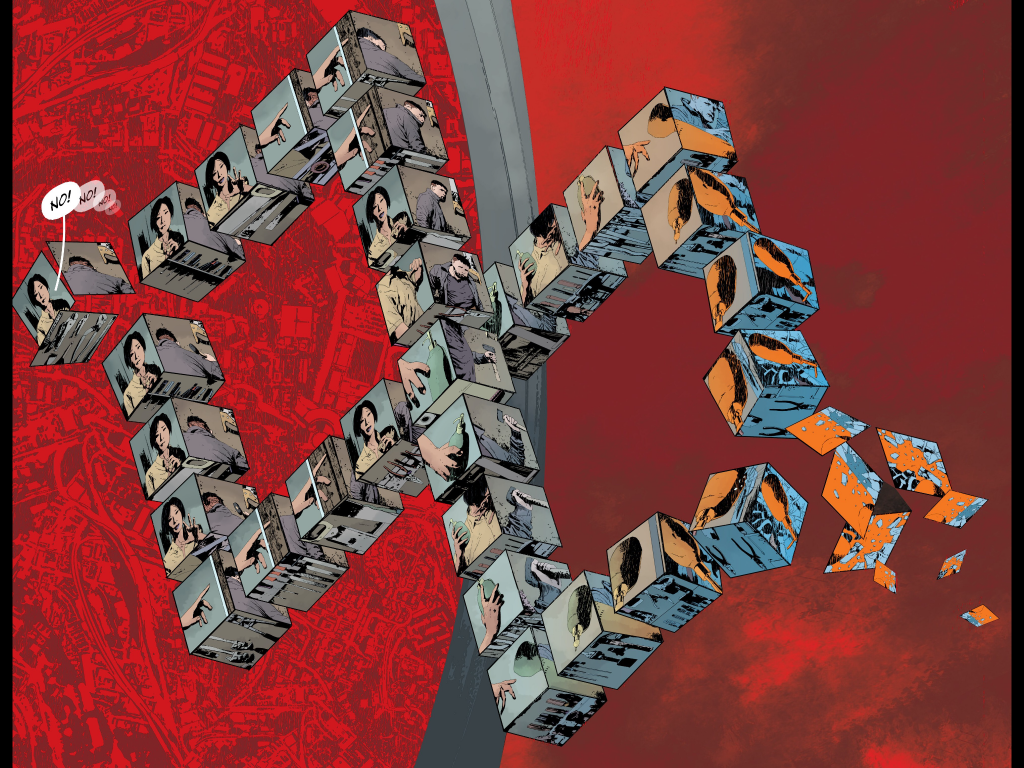You’ve watched everything on Shudder. You’ve read every book Stephen King ever wrote. You’ve even seen every episode of Hulu’s Into the Dark. So now where can a horror lover get their next scare? Maybe horror comics are the answer you’ve been looking for?
Fortunately, comic book creators have been flocking to horror over the past few years. Like their superhero brethren, horror comics can offer mind-twisting visuals that other media can’t quite provide. By mixing words and images, comics involve readers’ imaginations while using pictures to push their minds into places they would never go on their own.
With the expansion of third-party publishers like Aftershock Comics and with indie mainstays like Image moving away from cape books, writers and artists have many places to let their creativity run to the dark side. So if you’d like to get some four-color fear, here are ten recent horror comics that will keep you up at night.

Horror has always been an ideal genre for addressing social ills such as racism. But writer Pornsak Pichetshote takes it to the next level in his comic Infidel, drawn by artist Aaron Campbell. The tale of Aisha and Medina, two Muslim women of color and longtime friends living in an apartment building that recently housed a suspected terrorist, Infidel is a ghost story about the ghosts that still haunt America. Pichetshote grounds his characters with believable dialogue (even as they discuss heavy issues), and Campbell’s frantic linework creates figures who are both recognizably human and relatably flawed. But when covered with José Villarrubia’s unsettling colors and designer Jeff Powell’s inventive lettering, the human and the supernatural collide to make a terrifying, but ultimately compassionate, piece of fiction.

Too often, “Cosmic Horror” brings to mind only images of Cthulhu rising from the deep or unknowable aliens arriving from space. But in their series Gideon Falls, writer Jeff Lemire, artist Andrea Sorrentino, and colorist Dave Stewart add a new menacing figure to the sub-genre: the Black Barn. Over 21 issues, Gideon Falls unravels the mystery of the Black Barn, a haunted building that appears to those going mad, including the series’ protagonists, a struggling priest and a life-long mental patient. Sorrentino and Stewart create some of the most unique and disturbing visuals in horror of any medium, including a fantastic cubic double-helix that brings together two characters in different times and places. It’s the kind of thing one can only see in a comic book, a rare example of ineffable horror.

As a head writer for The Daily Show and Mystery Science Theater 3000, Elliott Kalan has made the very serious look very ridiculous. But Kalan does the opposite with Maniac of New York, offering a grimly realistic take on silly slashers like Friday the 13th Part VII: Jason Takes Manhattan. In Maniac of New York, Kalan and artist Andrea Mutti follow the municipal response to a seemingly unstoppable masked killer. By focusing on the mundane parts of a fantastical story, Kalan and Mutti heighten the horror in the established slasher genre, showing how people “just doing their jobs” can be the only thing between a normal life in New York and a grisly death.

When it comes to dead children in horror, it’s hard to top Stephen King or Guillermo Del Toro. But James Tynion IV and Werther Dell’Edera come close with their Eisner-nominated series Something is Killing the Children. When the children of Archer’s Peak begin to go missing, a mysterious drifter named Erica Slaughter arrives to help. Dell’Edera is never precious about depicting young children being ripped apart by an insect-like monster, and colorist Miquel Muerto heightens the drama by washing the creatures in sickly greens and blues. But Tynion finds plenty of spaces for believable emotions and actual humor to enrich the characters, never falling back on “Man with No Name” stereotypes when writing monster hunter Slaughter.

For years, DC Comics’ Vertigo imprint was the premier home for horror comics, producing landmark Sandman and Hellblazer runs. But even though DC shuttered Vertigo in 2020, its spirit remains alive in the Hill House imprint, curated by author Joe Hill. For his first run, Hill scored a coup by recruiting Nebula Award-winning writer Carmen Maria Machado for The Low, Low Woods, drawn by Dani and colored by Tamra Bonvillain, with letters by Steve Wands. Set in the richly realized mining town of Shudder-to-Think, Pennsylvania, The Low, Low Woods tells a horrifying story of systemic misogyny and the cruelties of capitalism from the perspective of teen girls El and Octavia. Dani’s scratchy artwork recalls the linework of Vertigo in its prime, powerfully rendering women with sinkholes in their bodies and skinless men. But it’s the believable motivations of the city’s men that make The Low, Low Woodstruly terrifying.

While Vertigo may have established DC as horror’s home with the Big Two publishers, it’s important to remember that Marvel was in the monster business before it did superheroes. In fact, many of the first Marvel heroes, including Spider-Man and the Thing, were originally designed to be monsters. That’s particularly true of the Hulk, who was a Jekyll and Hyde riff who became a monster at night. Writer Al Ewing brought that element back for The Immortal Hulk, an environmental allegory that ties the gamma energy that transformed Bruce Banner into the Hulk to Satan and Hell. Artist Joe Bennett and inker Ruy José draw from Rob Bottin’s effects on John Carpenter’s The Thing to make Banner’s transformations feel painful and visceral. Combined with Paul Mounts’s other-worldly colors, The Immortal Hulk successfully mixes body horror with supernatural terror to create one of the scariest comics currently running.

Unsurprisingly, master horror mangaka Junji Ito goes to some pretty weird places in his collection Venus in the Blind Spot, including stories about a man hiding in an easy chair and body-shaped holes in caves. But the collection’s most chilling story is its first one, “Billions Alone.” Just as young agoraphobe Michio finally decides to enter the world again, he must deal with a killer who’s sewing people together. What begins with a lone joined couple quickly spreads to larger and larger groups, giving Ito a reason to draw disturbing tableaux of bodies joined together. But this grisly conceit serves to explore themes of loneliness and a fear of groups, a concept that hits that much harder during a pandemic.

First, I need to make this clear. The most terrifying thing Chip Zdarsky ever wrote was this one-panel Frog-Man bit in Original Sins #5. But Stillwater comes pretty close. Co-created and drawn by Ramón K. Perez, with colors by Mike Spicer and letters from Rus Wooton, Stillwater takes place in a town where no one can die. While that sounds good, the town’s strange ability means that no one can age, including children, which drives a desperate mother to sneak her toddler son Thomas out of Stillwater. But when circumstances bring a now-grown Thomas back to the town he no longer remembers, tensions and Stillwater grow between those who long for outside contact and the fascist Judge who wants to keep them hidden from the world. While that synopsis makes for good thriller material, Zdarsky and Perez take the story to some genuinely disturbing places, including characters being buried in the ground for weeks on end or living through a bomb explosion.

The other standout in Hill House Comics’ inaugural batch is the Victorian ghost story Daphne Byrne, written by Laura Marks and drawn by horror legend Kelly Jones. Daphne Byrne follows the adolescent title character after her father’s death in Victorian England. While her mother’s loneliness drives her to a disreputable medium, who has darker plans for the Byrne family, Daphne is visited by a dark young man who promises the girl companionship and power. In the classic Victorian style, Daphne Byrne blurs the lines between fantasy and reality. But instead of only asking us to question Daphne, Marks and Jones make everyone into an unreliable narrator of their own stories, from the man suddenly wooing Daphne’s mother to the elderly rationalist who offers his help.

In addition to writing some of the best recent horror comics (including Something is Killing the Children!), James Tynion IV has teamed with writer Steve Foxe to bring back the anthology comic with Razorblades: The Horror Magazine. In its first three issues, Razorblades has already featured some truly memorable stories, but my favorite so far is “Strands,” by Jess Unkel and Jenn St-Onge. St-Onge’s vibrant linework and innocent figures belie a chilling story about a widower who notices bits of her late husband’s hair still lingering in her home. Both a sweet story about missing a loved one and a genuinely haunting tale, “Strands” builds to a satisfyingly shocking ending.
